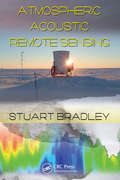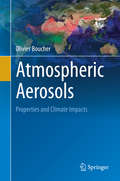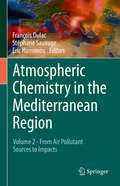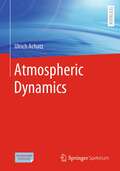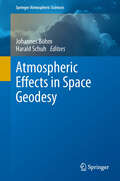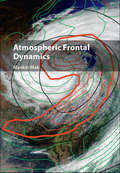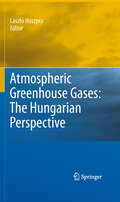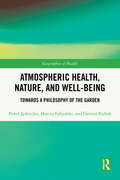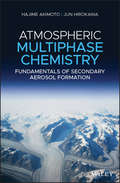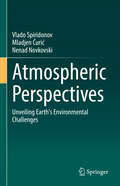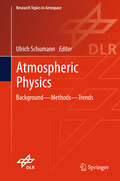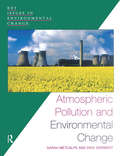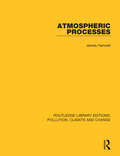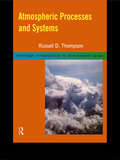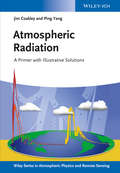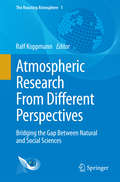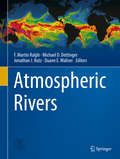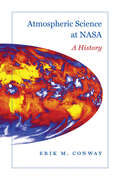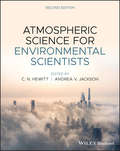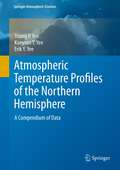- Table View
- List View
Atmospheric Acoustic Remote Sensing: Principles and Applications
by Stuart BradleySonic Detection and Ranging (SODAR) systems and Radio Acoustic Sounding Systems (RASS) use sound waves to determine wind speed, wind direction, and turbulent character of the atmosphere. They are increasingly used for environmental and scientific applications such as analyzing ground-level pollution dispersion and monitoring conditions affecting wi
Atmospheric Aerosols: Characteristics and Radiative Effects
by S RamachandranThis book includes basic knowledge and understanding on the characteristics of aerosols over the continent and oceanic regions, their composition, residence times, sinks and size distributions, and their effects in the radiative transfer and climate of Earth.
Atmospheric Aerosols: Properties and Climate Impacts (Springer Atmospheric Sciences)
by Olivier BoucherThis textbook aims to be a one stop shop for those interested in aerosols and their impact on the climate system. It starts with some fundamentals on atmospheric aerosols, atmospheric radiation and cloud physics, then goes into techniques used for in-situ and remote sensing measurements of aerosols, data assimilation, and discusses aerosol-radiation interactions, aerosol-cloud interactions and the multiple impacts of aerosols on the climate system. The book aims to engage those interested in aerosols and their impacts on the climate system: graduate and PhD students, but also post-doctorate fellows who are new to the field or would like to broaden their knowledge. The book includes exercises at the end of most chapters. Atmospheric aerosols are small (microscopic) particles in suspension in the atmosphere, which play multiple roles in the climate system. They interact with the energy budget through scattering and absorption of solar and terrestrial radiation. They also serve as cloud condensation and ice nuclei with impacts on the formation, evolution and properties of clouds. Finally aerosols also interact with some biogeochemical cycles. Anthropogenic emissions of aerosols are responsible for a cooling effect that has masked part of the warming due to the increased greenhouse effect since pre-industrial time. Natural aerosols also respond to climate changes as shown by observations of past climates and modelling of the future climate.
Atmospheric Boundary Layer
by Jordi Vilà-Guerau De Arellano Chiel C. Van Heerwaarden Bart J. H. Van Stratum Kees Van Den DriesBased on more than twenty years of research and lecturing, Jordi Vilà-Guerau de Arellano and his team's textbook provides an excellent introduction to the interactions between the atmosphere and the land for advanced undergraduate and graduate students and a reference text for researchers in atmospheric physics and chemistry, hydrology, and plant physiology. The combination of the book, which provides the essential theoretical concepts, and the associated interactive Chemistry Land-surface Atmosphere Soil Slab (CLASS) software, which provides hands-on practical exercises and allows students to design their own numerical experiments, will prove invaluable for learning about many aspects of the soil-vegetation-atmosphere system. This book has a modular and flexible structure, allowing instructors to accommodate it to their own learning-outcome needs.
Atmospheric Chemistry in the Mediterranean Region: Volume 1 - Background Information and Pollutant Distribution
by François Dulac Stéphane Sauvage Eric HamonouThis two-volume set provides an extensive review of the abundant past and recent literature on the atmospheric chemistry in the Mediterranean region. The books document the experience gained on the atmospheric composition over the Mediterranean basin and close areas after almost six decades of studies, starting from early studies of radioactive aerosol fallouts and intense desert dust events in the 1960s, aerosol samples collected during oceanographic cruises in the early 1980s and including discoveries from subsequent surface monitoring stations, intensive campaigns, satellite climatologies, laboratory studies, as well as chemistry-transport and climate models. Through ten thematic sections, the authors examine the sources and fates of atmospheric pollutants over the Mediterranean basin and what we know about their major impacts on air quality and health, on the radiative budget and climate, on marine chemistry and biogeochemistry. This overview not only considers the full cycle of both aerosol and reactive gases including emissions, transport, transformation, and sinks, but also addresses the main impacts of the regional atmospheric chemistry. The volumes are an initiative from the ending ChArMEx project that has federated many studies on those topics in the past decade, and update the scientific knowledge by integrating the ChArMEx and non-ChArMEx literature. The books are contributed by a large pool of well-known authors from the respective fields, mainly from France and Greece, but also from fourteen other countries. All chapters have been peer-reviewed by international scientific experts in the corresponding domains. Volume 1 provides background information on the Mediterranean atmosphere, and focuses on the synoptic and dynamic conditions affecting pollutant concentrations over the Mediterranean basin, aerosol concentrations and variability, and reactive gas concentrations and variability. The targeted audience is the academic community working on atmospheric chemistry and its impacts on climate, air quality and marine biogeochemistry, especially teams having a special interest in the Mediterranean region, which includes many countries and institutes worldwide.
Atmospheric Chemistry in the Mediterranean Region: Volume 2 - From Air Pollutant Sources to Impacts
by François Dulac Stéphane Sauvage Eric HamonouThis two-volume set provides an extensive review of the abundant past and recent literature on the atmospheric chemistry in the Mediterranean region. The books document the experience gained on the atmospheric composition over the Mediterranean basin and close areas after six decades of research, starting from early studies of radioactive aerosol fallouts and intense desert dust events in the 1960s, followed by studies of aerosols collected during oceanographic cruises in the early 1980s, and including subsequent knowledge from various surface monitoring stations, intensive campaigns, satellite climatologies, laboratory studies, as well as chemistry-transport and climate models. Through ten thematic sections, the authors examine the sources and fates of atmospheric pollutants over the Mediterranean basin and what we know about the main impacts of the regional atmospheric chemistry. This overview not only considers the full regional cycle of both aerosol and reactive gases including emissions, transport, transformations, and sinks, but also addresses their major impacts on air quality and health, on the radiative budget and climate, on marine chemistry and biogeochemistry . The volumes are an initiative from the ChArMEx project that has federated many studies on those topics in the 2010-2020decade, and update the scientific knowledge by integrating the ChArMEx and non-ChArMEx literature. The books are contributed by a large pool of well-known authors from the respective fields, mainly from France and Greece, but also from six other Mediterranean and eight non-Mediterranean countries. All Chapters have been peer-reviewed by international scientific experts in the corresponding domains. Volume 2 focuses on emissions and their sources, recent progress on chemical processes, aerosol properties, atmospheric deposition, and the impacts of air pollution on human health, regional climate and ecosystems. Recommendations for future research in these fields are finally proposed. The targeted audience is the academic community working on atmospheric chemistry and its impacts, especially teams having an l interest in the Mediterranean region, which includes many countries and institutes worldwide.
Atmospheric Dynamics
by Mankin MakMankin Mak's textbook provides a self-contained course on atmospheric dynamics. The first half is suitable for senior undergraduates, and develops the physical, dynamical and mathematical concepts at the fundamental level. The second half of the book is aimed at more advanced students who are already familiar with the basics. The contents have been developed from many years of the author's teaching at the University of Illinois. Discussions are supplemented with schematics, weather maps and statistical plots of the atmospheric general circulation. Students often find the connection between theoretical dynamics and atmospheric observation somewhat tenuous, and this book demonstrates a strong connection between the key dynamics and real observations. This textbook is an invaluable asset for courses in atmospheric dynamics for advanced students and researchers in atmospheric science, ocean science, weather forecasting, environmental science, and applied mathematics. Some background in mathematics, physics and basic atmospheric science is assumed.
Atmospheric Dynamics
by Ulrich AchatzThis textbook is intended for both undergraduate and graduate courses in meteorology and atmospheric sciences, as well as for researchers working on theoretical and numerical aspects of weather and climate or on geophysical fluid dynamics. The treatment is concise, thorough, and self-contained. All necessary concepts are introduced, and the reader is given explicit guidance on all mathematical steps.The book begins with a derivation of the equations of motion. These are then used to discuss fundamental aspects of weather and climate. The mechanisms behind vortical motions, that are known from the daily weather map, are discussed. Shallow-water theory is introduced as a tool for an efficient analysis of key concepts, such as atmospheric waves and synoptic-scale vortices. Quasigeostrophic theory is described and then used to explain the occurrence and mechanisms of extratropical weather by means of baroclinic instability. The specific properties of the atmospheric boundary layer are discussed, with a focus on the interaction between turbulence and mean flows. This is followed by a detailed look at the global atmospheric circulation, highlighting its control by Rossby waves and gravity waves.At the same time, the reader is introduced to essential concepts that find applications in the field, such as balance by geostrophic and hydrostatic equilibrium, the role of entropy and potential temperature, potential vorticity, the Kelvin theorem, instability theory, the Reynolds equations, Eliassen-Palm and pseudo-momentum flux, multi-scale asymptotics, WKB theory, wave action, the transformed Eulerian mean, critical layers, and wave refraction.The text is supplemented by appendices on important mathematical concepts and further elaborations of the main text. Chapter summaries and reading recommendations help the reader not merely to keep focus on the essentials, but just as well to broaden the horizon.
Atmospheric Effects in Space Geodesy (Springer Atmospheric Sciences)
by Harald Schuh Johannes BöhmVarious effects of the atmosphere have to be considered in space geodesy and all of them are described and treated consistently in this textbook. Two chapters are concerned with ionospheric and tropospheric path delays of microwave and optical signals used by space geodetic techniques, such as the Global Navigation Satellite Systems (GNSS), Very Long Baseline Interferometry (VLBI), or Satellite Laser Ranging (SLR). It is explained how these effects are best reduced and modelled to improve the accuracy of space geodetic measurements. Other chapters are on the deformation of the Earth's crust due to atmospheric loading, on atmospheric excitation of Earth rotation, and on atmospheric effects on gravity field measurements from special satellite missions such as CHAMP, GRACE, and GOCE. All chapters have been written by staff members of the Department of Geodesy and Geoinformation at TU Wien who are experts in the particular fields.
Atmospheric Frontal Dynamics
by Mankin MakAtmospheric Frontal Dynamics is the first book to present a self-contained and comprehensive coverage of the ubiquitous surface and upper-level fronts, which are boundaries separating two air masses of different densities. Atmospheric fronts are a product of interaction between planetary, synoptic, meso and small scales of motions. They are uniquely important in weather forecasting since many meteorological phenomena are closely associated with them. The discussions of the multifaceted aspects of basic frontal dynamics are based on illustrative analyses of a hierarchy of semi-geostrophic frontal models performed in physical, as opposed to geostrophic, coordinates. Such analyses enable us to systematically and quantitatively delineate the physical nature of different types of fronts in a relatively straightforward manner. They are further supplemented by two illustrative analyses using a state-of-the-art model. 'Learning-by-doing' is the guiding principle behind the book, making it an asset to both students and instructors in atmospheric science and meteorology.
Atmospheric Greenhouse Gases: The Hungarian Perspective
by László HaszpraHuman induced global climate change is the biggest challenge humankind faces today. Increasing amount of atmospheric greenhouse gases play a crucial role in the evolution of the climate. Without the understanding of the contributing processes, feedbacks and interactions we cannot predict the future changes and develop effective mitigation strategies. To decrease the uncertainty of the global studies detailed regional studies are needed surveying the regional characteristics of the atmospheric greenhouse gas budget and the influencing factors. Atmospheric Greenhouse Gases: The Hungarian Perspective covers a coherent subset of the Hungarian climate change oriented research that is directly related to greenhouse gases. Topics discussed in the book range from the monitoring of the concentrations and fluxes of atmospheric greenhouse gases, through the modeling of atmosphere-biosphere interaction and greenhouse gas exchange processes, to the review of the anthropogenic contribution of Hungary to the greenhouse gas budget of the atmosphere. The studies call the attention to the regional properties which may modulate the European scale or global picture on the variation of atmospheric greenhouse gases.
Atmospheric Health, Nature, and Well-being: Towards a Philosophy of the Garden (Geographies of Health Series)
by Marcin Fabjański Paweł Jędrzejko Dariusz KubokReimagining the garden as a vital metaphysical framework for understanding the intricate relationships between health, well-being, and the environment, the book proposes a holistic, ecologically sensitive model that integrates mind, body, nature, and community.The text offers the reader a transformative perspective that, transcending traditional dualisms, embraces the atmospheric sense of deep interconnectedness between individuals, communities, and the natural world. Through a blend of philosophical analysis, autoethnographic narratives, and cultural reflections, the authors, proposing a transgressive metaphysical model for personal and communal engagement with the processes of life, revise the idea of health as “lack of illness,” redefining it as “flourishing.” Such garden-inspired metaphysics promotes a dynamic, inclusive understanding of health, balancing modern medical approaches with a profound attunement to the rhythms of nature.Atmospheric Health, Nature, and Well-being is an ideal resource for scholars, students, and other professionals in philosophy, environmental studies, health sciences, and cultural studies, as well as policymakers, urban planners, and anyone interested in innovative approaches to health, well-being, and the environment.
Atmospheric Multiphase Chemistry: Fundamentals of Secondary Aerosol Formation
by Hajime Akimoto Jun HirokawaAn important guide that highlights the multiphase chemical processes for students and professionals who want to learn more about aerosol chemistry Atmospheric Multiphase Reaction Chemistry provides the information and knowledge of multiphase chemical processes and offers a review of the fundamentals on gas-liquid equilibrium, gas phase reactions, bulk aqueous phase reactions, and gas-particle interface reactions related to formation of secondary aerosols. The authors—noted experts on the topic—also describe new particle formation, and cloud condensation nuclei activity. In addition, the text includes descriptions of field observations on secondary aerosols and PM2.5. Atmospheric aerosols play a critical role in air quality and climate change. There is growing evidence that the multiphase reactions involving heterogeneous reactions on the air-particle interface and the reactions in the bulk liquid phase of wet aerosol and cloud/fog droplets are important processes forming secondary aerosols in addition to gas-phase oxidation reactions to form low-volatile compounds. Comprehensive in scope, the book offers an understanding of the topic by providing a historical overview of secondary aerosols, the fundamentals of multiphase reactions, gas-phase reactions of volatile organic compounds, aqueous phase and air-particle interface reactions of organic compound. This important text: Provides knowledge on multiphase chemical processes for graduate students and research scientists Includes fundamentals on gas-liquid equilibrium, gas phase reactions, bulk aqueous phase reactions, and gas-particle interface reactions related to formation of secondary aerosols Covers in detail reaction chemistry of secondary organic aerosols Written for students and research scientists in atmospheric chemistry and aerosol science of environmental engineering, Atmospheric Multiphase Reaction Chemistry offers an essential guide to the fundamentals of multiphase chemical processes.
Atmospheric Perspectives: Unveiling Earth's Environmental Challenges
by Vlado Spiridonov Mladjen Ćurić Nenad NovkovskiEarth is a complex and ever-changing system, where the atmosphere, oceans, land, and life interact in intricate ways. Atmospheric Perspectives: Unveiling Earth's Environmental Challenges takes readers on a fascinating journey through the science behind these connections, from the planet&’s origins to the present era of climate transformation.Bridging modern scientific insights with a broader understanding of environmental change, this book explores the forces shaping our globe—from atmospheric dynamics and oceanic circulation to biodiversity, natural hazards, and human impacts. With accelerating climate shifts and growing environmental challenges, understanding Earth&’s delicate balance has never been more crucial.Whether you are a student, researcher, or simply curious about our world, this book offers a compelling exploration of the natural systems that sustain life—and the urgent need to protect them.
Atmospheric Physics: Background – Methods – Trends (Research Topics in Aerospace)
by Ulrich SchumannOn the occasion of the 50th anniversary of the Institute of Atmospheric Physics of the German Aerospace Center (DLR), this book presents more than 50 chapters highlighting results of the institute's research.The book provides an up-to-date, in-depth survey across the entire field of atmospheric science, including atmospheric dynamics, radiation, cloud physics, chemistry, climate, numerical simulation, remote sensing, instruments and measurements, as well as atmospheric acoustics. The authors have provided a readily comprehensible and self-contained presentation of the complex field of atmospheric science. The topics are of direct relevance for aerospace science and technology. Future research challenges are identified.
Atmospheric Pollution and Environmental Change (Key Issues in Environmental Change)
by Sarah Metcalfe Dick DerwentAtmospheric Pollution and Environmental Change is an introduction to the major pollutants causing concern today, a description of their sources and how their emissions and concentrations have changed through time.Approaching atmospheric change in the context of its effects on the natural environment, people and the global climate system, Atmospheric Pollution and Environmental Change examines: ·Atmospheric pollution at global, continental and local scales ·The development of policy at national and international levels·The uses of computer models to help us understand and forecast the behaviour of pollutants and their impacts·The success (or otherwise) of policies designed to reduce air pollution and the prospects for the future.With extensive references to useful web sites and further reading, Atmospheric Pollution and Environmental Change will be of great benefit to senior undergraduate and postgraduate students.
Atmospheric Processes
by James HanwellOriginally published in 1980, this book is an original approach to the study of the atmosphere at A Level and introductory undergraduate courses. A true understanding of the way the atmosphere works is only attainable on a firm basis of science and the book concentrates on this aspect in a clear and straightforward manner without introducing advanced mathematics. The book discusses the atmosphere in terms of a machine fuelled by the Sun and it deals with the energy involved in global circulations before looking at local processes and finally global patterns. With a clear recognition of the vulnerability of climate to our wellbeing on a global scale, this book remains as relevant now as when it was first published.
Atmospheric Processes and Systems (Routledge Introductions to Environment: Environmental Science)
by Russell D. ThompsonAtmospheric Processes and Systems presents a concise introduction to the atmosphere and the fundamentals of weather. Examining different aspects of the mass, energy and circulation systems in the atmosphere, this text provides detailed accounts of specific phenomena, including* the composition and structure of the atmosphere* energy transfers* the cycle of atmospheric water in terms of evaporation, condensation and precipitation* pressure and winds at the primary or global scale* secondary air masses and fronts* thermal differences and weather disturbances.The text includes sixteen boxed case studies, annotated further reading lists and a glossary of key terms.
Atmospheric Radar
by Wayne K. Hocking Jürgen Röttger Robert D. Palmer Toru Sato Phillip B. ChilsonRichly illustrated, and including both an extensive bibliography and index, this indispensable guide brings together the theory, design, and applications of atmospheric radar. It explains the basic thermodynamics and dynamics of the troposphere, stratosphere, and mesosphere, and discusses the physical and engineering principles behind one of the key tools used to study these regions - MST radars. Key topics covered include antennas, signal propagation, and signal processing techniques. A wide range of practical applications are discussed, including the use of atmospheric radar to study wind profiles, tropospheric temperature, and gravity waves. A detailed overview of radar designs provides a wealth of knowledge and tools, providing readers with a strong basis for building their own instruments. This is an essential resource for graduate students and researchers working in the areas of radar engineering, remote sensing, meteorology, and atmospheric physics, as well as for practitioners in the radar industry.
Atmospheric Radiation
by Ping Yang James A. Coakley Jr.A first-look at radiative transfer in planetary atmospheres with a particular focus on the Earth's atmosphere and climate. The textbook covers the basics of the radiative transfer of sunlight, treating absorption and scattering, and the transfer of the thermal infrared appropriate for local thermodynamic equilibrium, absorption and emission. The examples included show how the solutions of the radiative transfer equation are used in remote sensing to probe the thermal structure and composition of planetary atmospheres. This motivates students by leading them to a better understanding of and appreciation for the computer-generated numerical results. Aimed at upper-division undergraduates and beginning graduate students in physics and atmospheric sciences, the book is designed to cover the essence of the material in a 10-week course, while the material in the optional sections will facilitate its use at the more leisurely pace and in-depth focus of a semester course.
Atmospheric Research From Different Perspectives: Bridging the Gap Between Natural and Social Sciences (The Reacting Atmosphere #1)
by Ralf KoppmannThe book, the first in a series arising from the research network The Reacting Atmosphere, explains and outlines the aims of this ambitious cross-disciplinary effort. The central topic is air quality and climate change, and the methods of atmospheric physics and chemistry, applied mathematics and socio-economic science are used to advance the understanding of the role of the atmosphere in global change.
Atmospheric Rivers
by F. Martin Ralph Michael D. Dettinger Jonathan J. Rutz Duane E. WaliserThis book is the standard reference based on roughly 20 years of research on atmospheric rivers, emphasizing progress made on key research and applications questions and remaining knowledge gaps. The book presents the history of atmospheric-rivers research, the current state of scientific knowledge, tools, and policy-relevant (science-informed) problems that lend themselves to real-world application of the research—and how the topic fits into larger national and global contexts. This book is written by a global team of authors who have conducted and published the majority of critical research on atmospheric rivers over the past years. The book is intended to benefit practitioners in the fields of meteorology, hydrology and related disciplines, including students as well as senior researchers.
Atmospheric Science at NASA: A History (New Series in NASA History)
by Erik M. ConwayHonorable Mention, 2008 ASLI Choice Awards. Atmospheric Science Librarians InternationalThis book offers an informed and revealing account of NASA’s involvement in the scientific understanding of the Earth’s atmosphere. Since the nineteenth century, scientists have attempted to understand the complex processes of the Earth’s atmosphere and the weather created within it. This effort has evolved with the development of new technologies—from the first instrument-equipped weather balloons to multibillion-dollar meteorological satellite and planetary science programs. Erik M. Conway chronicles the history of atmospheric science at NASA, tracing the story from its beginnings in 1958, the International Geophysical Year, through to the present, focusing on NASA’s programs and research in meteorology, stratospheric ozone depletion, and planetary climates and global warming. But the story is not only a scientific one. NASA’s researchers operated within an often politically contentious environment. Although environmental issues garnered strong public and political support in the 1970s, the following decades saw increased opposition to environmentalism as a threat to free market capitalism. Atmospheric Science at NASA critically examines this politically controversial science, dissecting the often convoluted roles, motives, and relationships of the various institutional actors involved—among them NASA, congressional appropriation committees, government weather and climate bureaus, and the military.
Atmospheric Science for Environmental Scientists
by C. N. Hewitt Andrea V. JacksonEnlightens readers on the realities of global atmospheric change, including global warming and poor air quality Climate change and air pollution are two of the most pressing issues facing Mankind. This book gives undergraduate and graduate students, researchers and professionals working in the science and policy of pollution, climate change and air quality a broad and up-to-date account of the processes that occur in the atmosphere, how these are changing as Man’s relentless use of natural resources continues, and what effects these changes are having on the Earth’s climate and the quality of the air we breathe. Written by an international team of experts, Atmospheric Science for Environmental Scientists, 2nd Edition provides an excellent overview of our current understanding of the state of the Earth’s atmosphere and how it is changing. The first half of the book covers: the climate of the Earth; chemical evolution of the atmosphere; atmospheric energy and the structure of the atmosphere; biogeochemical cycles; and tropospheric chemistry and air pollution. The second half looks at cloud formation and chemistry; particulate matter in the atmosphere; stratospheric chemistry and ozone depletion; boundary layer meteorology and atmospheric dispersion; urban air pollution; and global warming and climate change science. Provides succinct but detailed information on all the important aspects of atmospheric science for students Offers the most up-to-date treatment of key issues such as stratospheric chemistry, urban air pollution, and climate change Each chapter includes basic concepts, end-of-section questions, and more in-depth material Features contributions from the best experts and educators in the field of atmospheric science Atmospheric Science for Environmental Scientists, 2nd Edition is an invaluable resource for students, teachers, and professionals involved in environmental science. It will also appeal to those interested in learning how the atmosphere works, how humankind is changing its composition, and what effects these changes are leading to.
Atmospheric Temperature Profiles of the Northern Hemisphere: A Compendium of Data (Springer Atmospheric Sciences)
by Young Yee Erik Y. Yee Kueyson Y. YeeFor more than three decades, the US Standard Atmosphere has been used by researchers and professionals in many areas of aeronautics and atmospheric sciences. It is an idealized, all season average temperature profile of the earth's atmosphere. But today's modern day and sophisticated global applications require more extensive representations of the mean temperature profile. This book is a global augmentation of the climatological tropospheric temperature profiles in the Northern Hemisphere for different latitude belts and seasons. There are 72 mean temperature profile tables from the surface up to 10 kilometers in height that represent the four seasons for different latitudinal belts (5° N, 10° N , 15° N, 20° N, 25° N, 30° N, 35° N, 40° N, 45° N, 50° N, 55° N, 60° N, 65° N, 70° N, 75° N, 80° N, 85° N). The model is based on a neural network algorithm that uses archived radiosonde data, retrieved temperature profiles from remote sensors, and the solar insolation at the top of the earth's atmosphere. It is the most comprehensive book of mean seasonal tropospheric temperature profiles to date. It will be an indispensible reference to the aeronautic and meteorological industries worldwide as well as an easy-to-use guide for climatologists, meteorologists, aeronautic engineers, researchers and aviators.
